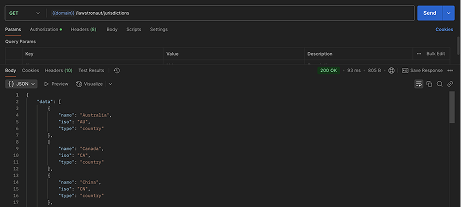Features
Legal Document Retrieval for AI
Direct Access to Global Laws and Regulations.
Gain immediate access to the essential texts of laws and regulations, ensuring your initial legal research and compliance efforts are as comprehensive as possible.

Links to legal sources
Get the links to the official publication of the law on the government website.

Full Text Retrieval
Directly access the full texts of laws and regulations from jurisdictions around the globe.

Metadata Insights
Receive critical metadata with each document, including jurisdiction, publication date, and document type.
Built with developers needs in mind.
The Lawstronaut API
- RESTful, fully featured, easy to integrate with.
- Has predictable resource-oriented URLs, returns JSON-encoded responses, and uses standard HTTP status codes and verbs.
- Uses API keys to authenticate requests. Lawstronaut supports oAuth 2.0 authentication.
- Is best used through URL.

Everything you need to train your legaltech AI.
Document retrieval
Access legal documents from various jurisdictions, right from the source

Full text of laws and regulations
Access full text of laws, regulations, and official guidelines.

Comprehensive API Documentation
Clear instructions, examples, and best practices to help developers easily integrate and optimize their use of the API.

Metadata access
Access metadata that includes jurisdiction, date of publication, type of law, issuing authority, and language.

Updates and version
Access legal documents from various jurisdictions, right from the source

Jurisdiction-Specific Filtering
Filter content by specific countries or regions, like the European Union or the United States, to focus on relevant jurisdictions.

The Meta data.
Receive valuable data about each law, including:
- Title: The official title of the law or regulation.
- Document Number: Often laws and regulations have a specific number or code that identifies them, such as a statute number or a regulation code.
- Jurisdiction: The geographic or organizational scope over which the law or regulation has authority (e.g., country, state, city, or agency).
- Issuing Authority: The government body or agency that issued the law or regulation.
- Date of Enactment: The date on which the law was officially enacted or signed into law.
- Date of Last Amendment: The most recent date on which the law was amended, which is crucial for understanding the current version.
- Publication Date: The date when the law or regulation was officially published, which might differ from the enactment date.
- Effective Date: The date when the law or regulation comes into force.
- Expiration Date: If applicable, the date when the law is no longer in effect.
- Legal References: Citations or references to other relevant laws or regulations mentioned within the document.
- Keywords: A set of relevant keywords or tags that summarize the content or context of the law or regulation.
- Summary/Abstract: A brief description or abstract of the law’s purposes and main points.
- Full Text: The complete textual content of the law or regulation.
- Status: Current status of the law (e.g., in force, repealed, proposed).
- Type of Law: The classification of the law, such as constitutional, statutory, regulatory, case law, or administrative.
- Language: The language(s) in which the law is published.
- URL: The web address where the law or regulation can be accessed, which is useful for verification and updates.


